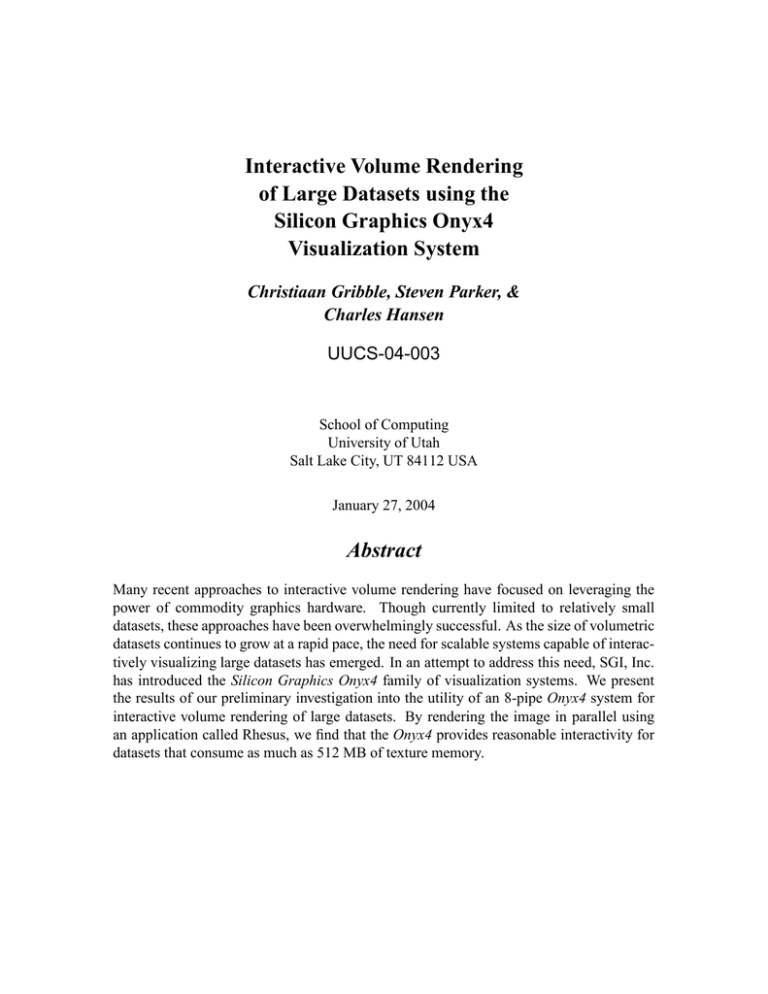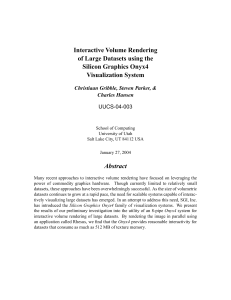Interactive Volume Rendering of Large Datasets using the Silicon Graphics Onyx4 Visualization System
advertisement

Interactive Volume Rendering
of Large Datasets using the
Silicon Graphics Onyx4
Visualization System
Christiaan Gribble, Steven Parker, &
Charles Hansen
UUCS-04-003
School of Computing
University of Utah
Salt Lake City, UT 84112 USA
January 27, 2004
Abstract
Many recent approaches to interactive volume rendering have focused on leveraging the
power of commodity graphics hardware. Though currently limited to relatively small
datasets, these approaches have been overwhelmingly successful. As the size of volumetric
datasets continues to grow at a rapid pace, the need for scalable systems capable of interactively visualizing large datasets has emerged. In an attempt to address this need, SGI, Inc.
has introduced the Silicon Graphics Onyx4 family of visualization systems. We present
the results of our preliminary investigation into the utility of an 8-pipe Onyx4 system for
interactive volume rendering of large datasets. By rendering the image in parallel using
an application called Rhesus, we find that the Onyx4 provides reasonable interactivity for
datasets that consume as much as 512 MB of texture memory.
Interactive Volume Rendering of Large Datasets using the
Silicon Graphics Onyx4 Visualization System
Christiaan Gribble
Steven Parker
Charles Hansen
Scientific Computing and Imaging Institute, University of Utah
{cgribble|sparker|hansen}@sci.utah.edu
Figure 1: Visualizations of the temperature and velocity magnitude fields from a heptane pool fire simulation as they evolve through
time. These images were created using the scalar value, gradient, and Hessian components of the fire-spread datasets. Each
time-step consumes 512 MB of texture memory and was rendered in parallel at 0–8 frames per second on an 8-pipe Onyx4 system.
Abstract
Many recent approaches to interactive volume rendering have focused on leveraging the power of commodity graphics hardware.
Though currently limited to relatively small datasets, these approaches have been overwhelmingly successful. As the size of volumetric datasets continues to grow at a rapid pace, the need for
scalable systems capable of interactively visualizing large datasets
has emerged. In an attempt to address this need, SGI, Inc. has
introduced the Silicon Graphics Onyx4 family of visualization systems. We present the results of our preliminary investigation into
the utility of an 8-pipe Onyx4 system for interactive volume rendering of large datasets. By rendering the image in parallel using an
application called Rhesus, we find that the Onyx4 provides reasonable interactivity for datasets that consume as much as 512 MB of
texture memory.
CR Categories: I.3.2 [Computer Graphics]: Graphics Systems—
Distributed/network graphics I.3.7 [Computing Methodologies]:
Computer Graphics—3D Graphics
Keywords: Interactive volume rendering, parallel volume rendering, large datasets, visualization systems, Onyx4
1
Introduction
Volume rendering is a visualization technique that maps scalar values of a volumetric dataset to optical properties, typically color and
opacity, that can be used to render an image. The mapped quantity can be the original data value contained within the scalar field,
or it may be some other value that is derived from the field or
even measured using a neighborhood of sampled values within the
field. Common examples of derived quantities include the gradient
(first-order differential) and the Hessian (second-order differential),
though other quantities are certainly possible.
Unlike isosurfacing and other common visualization techniques,
volume rendering neither requires nor creates an intermediate geometric representation of the dataset for rendering. The scalar val-
ues are resampled, derived, or measured and then mapped to optical
properties via a transfer function as the image is being rendered.
In addition, volume rendering enables the simultaneous visualization of multiple scalar fields, that is, multiple sampled, derived,
or measured values. Multiple data fields effectively place the ranges
of data values representing different features at different locations
in a multi-dimensional data space, allowing better classification of
the data. These classification abilities lead to better visualizations,
which in turn lead to a better understanding of the data.
Many recent approaches to interactive volume rendering have
focused on leveraging the power of commodity graphics processing units (GPUs). The increasing programmability of these chips
means that they are capable of performing more general computations than the basic 3D graphics operations for which they are
designed. This programmability, when combined with the fast processor and memory speeds, makes commodity graphics hardware
useful for a variety of applications, and GPUs can now be used as
general coprocessors.
Implementing volume rendering using GPUs requires extensive
use of the texture mapping operations that these chips provide.
These operations quickly resample a discrete grid of texels to obtain values at locations that do not lie on the original grid. The
hardware alpha blending operations are then used to composite individual samples to determine the values that will be mapped via
the transfer function.
More specifically, the volumetric dataset is stored in the graphics hardware’s texture memory, either as a single 3D texture or as
a stack of 2D textures. Then locations at which the dataset will be
resampled are determined by rendering a proxy geometry with interpolated coordinates, typically texture-mapped quadrilaterals. Finally, the resulting texture-mapped geometry is composited from
back to front using alpha blending. Typical results of these texturebased techniques are shown in Figure 2.
An obvious constraint on the utility of texture-based volume rendering techniques is the size of the GPU’s locally available memory. Commodity graphics hardware currently features memory
sizes ranging from 64 MB to 256 MB.
Today’s medical, industrial, and scientific datasets already con-
2
(a)
(b)
(c)
(d)
Figure 2: Texture-based volume rendering—Visualizations of several small datasets: (a) a turbine blade, (b) the Visible Male head,
(c) a human tooth, and (d) the Chapel Hill head CT scan. Each
of these datasets is easily accommodated by the available texture
memory of a single Onyx4 pipe, and can be rendered at up to 8
frames per second.
sume many hundreds of megabytes of storage. As data acquisition
devices are becoming more accurate and as physical simulations are
becoming more complex, these already large volumetric datasets
are growing larger at a rapid pace. Moreover, multi-field visualizations require even more texture memory than simple single field
visualizations. Maintaining interactive frame rates when rendering
these large datasets can be quite difficult.
Current commodity graphics hardware cannot store these large
datasets in their local memories. While texture-swapping (a technique similar to virtual memory paging in operating systems) can
alleviate this problem, it imposes a significant performance penalty
when more than a few texture swaps are required per frame. The
interactivity provided by the texture-based techniques is therefore
greatly reduced. Hence, there is a need for scalable systems that
can interactively visualize large datasets.
In an attempt to address this need, SGI, Inc. has introduced
the Silicon Graphics Onyx4 family of visualization systems. The
Onyx4 combines the advantages of the SGI NUMAflex architecture,
namely high-bandwidth and scalability, with the power of commodity graphics hardware.
In the pages that follow, we present the results of our preliminary investigation into the utility of the Onyx4 for parallel volume
rendering. We begin with a high-level description of Rhesus, the
texture-based volume rendering application used in this investigation. Then, we scrutinize Rhesus’ performance on the Onyx4 and
clearly identify the factors that limit the attainable frame rate. We
conclude by outlining possible optimizations, as well as more general research directions, that could be considered for the Silicon
Graphics Onyx4 platform.
Parallel Volume Rendering with Rhesus
One obvious approach to visualizing large datasets interactively involves partitioning the data into several subvolumes and rendering
those chunks in parallel. This approach is taken by Rhesus, the
texture-based volume rendering application used in this investigation.
Rhesus is derived from a texture-based volume renderer called
Simian, which uses multi-dimensional transfer functions to visualize multi-field datasets. In addition, Simian employs direct manipulation widgets for defining the transfer function; for probing,
clipping, and classifying the data; and for shading and coloring the
resulting visualization.
Originally, Rhesus was targeted for a cluster of commodity computers equipped with nVidia GeForce FX 5900 graphics hardware;
this cluster is called Nebula. Using the Message Passing Interface
(MPI) standard, the parallel processes load and render a specific
subvolume of the dataset, and then combine the individual results
using the binary-swap compositing algorithm. This process is illustrated for two large datasets in Figure 8.
More specifically, the rendering pipeline employed by Rhesus
has five stages: (1) volume rendering, (2) draw order determination,
(3) framebuffer readback, (4) pixel swapping and compositing, and
(5) image display. (Only the display process executes stage 5.) This
pipeline is depicted in Figure 3. In stage 1, each process renders its
subvolume using the basic strategy described in Section 1. Rendering is followed by a round of MPI-based communication in stage 2,
which determines the proper draw order (that is, the order in which
regions of pixels will be swapped between nodes and composited
in stage 4). This order is based on the current frame’s viewpoint.
Stage 3 is simply the framebuffer readback: each process obtains
its image from the hardware framebuffer and stores that image in
main memory. Then, in stage 4, regions of pixels are swapped and
composited according to the order determined earlier. This stage invokes (possibly) several rounds of MPI communication, at the end
of which the display process will have the fully composited image
stored in its main memory. Finally, that image is drawn to the hardware framebuffer in stage 5, and the pipeline repeats.
Using the extensions to MPI programs (MPE) library, we are
able to measure the time required by each stage of the Rhesus
pipeline. An example of the results are shown in Figure 4.
For this evaluation, we have ported Rhesus to an 8-pipe Onyx4
system. In contrast to the Nebula cluster, the Onyx4 is a shared
memory multiprocessor. Moreover, the new system employs ATI
Fire GL X1 graphics hardware. (Further details of the Onyx4’s
hardware and software environment are listed in Table 1.) To promote portability between Nebula and the Onyx4, we chose not to
utilize the globally available shared memory; Rhesus is still implemented using MPI (in particular, SGI’s native implementation).
This choice is justified in Section 3, where it is shown that MPI
communication is not a limiting factor in Rhesus’ performance on
the Onyx4. In order to utilize the capabilities of the ATI graphics
hardware, however, changes to the volume rendering code were required. Specifically, ATI fragment programs are now used to render
the volume, rather than nVidia register combiners.
Figure 3: Rhesus rendering pipeline—The rendering pipeline has
five stages: volume rendering, draw order determination, framebuffer readback, pixel swapping and compositing, and image display.
Figure 4: Pipeline stage timings—A close-up view of the distribution of time spent rendering a typical frame using 8 Rhesus processes. Here, the green events correspond to stages 1 and 2 of the
rendering pipeline; the blue to stage 3; the red, yellow, and orange
to stage 4; and, finally, the purple to stage 5.
Component or
Subsystem
Characteristics
CPU
16 600 MHz IP35 processors
32 KB L1 I-cache (per processor)
32 KB L1 D-cache (per processor)
4 MB unified L2 cache (per processor)
MIPS R16000 processor chip revision 2.1
MIPS R16010 FP chip revision 2.1
Main memory
8192 MB, shared
ccNUMA interconnect
3D Graphics
8 ATI Fire GL X1 graphics accelerators
128 MB memory (each pipe)
ATI FireGL drivers
OpenGL version 1.3 Irix 6.5
GLX version 1.3 Irix 6.5
GLU version 1.3 Irix 6.5
significantly and begins to dominate the other stages of the binaryswap algorithm.
We have also used Rhesus to visualize several large VGH
datasets, including those shown in Figures 1, 6, and 8. In particular,
we report the performance characteristics observed when visualizing the Visible Woman head dataset depicted in Figure 6. This
dataset consumes 512 MB of texture memory and must be partitioned into eight 64 MB chunks. The subvolumes are rendered in
parallel using eight Rhesus processes.
Figure 7a depicts the pipeline timings obtained with MPE when
rendering 256x256 images of the Visible Woman head dataset.
Here, too, the rendering stage consumes the majority of the image
generation time and is nearly identical across all 8 pipes.
The timing results depicted in Figure 7a led to a more careful examination of the time consumed by the rendering, readback,
and pixel compositing stages. Using a technique we term “peeling the onion”, we measured the impact of each stage of the Rhesus pipeline on the overall frame rate achieved for 256x256 and
512x512 images. Limiting the number of pipeline stages that are
completed exposes the marginal impact of each stage on the attainable frame rate.
The results of peeling the onion are depicted in Figure 7b. Again,
the compositing stage appears to be a good candidate for further
optimization.
Finally, we measured the speedup achieved by removing individual calls from the Rhesus pipeline. In particular, we simply removed the volume rendering call first, then the readback call, and
finally, the pixel compositing call, leaving the rest of the Rhesus
pipeline intact and allowing it to run to completion. The results of
this experiment are given in Table 2. Rendering the data clearly has
the most significant impact, but these results also suggest that optimizing the compositing stage will result in improved frame rates.
4
Future Work
Overlapping Rhesus’ rendering and binary-swap compositing
phases using separate processes or threads is the most obvious
application-level optimization. The benefits of this optimization include improved performance and better utilization of the Onyx4’s
16-way architecture.
Additional performance gains may be possible by taking advantage of the system’s global shared memory. However, two factors
must be considered before expending the effort to modify Rhesus’
Table 1: The Onyx4 visualization system—The Onyx4 combines
the SGI NUMAflex architecture and commodity graphics hardware.
Here, we list the most pertinent hardware and software characteristics of the Onyx4 system used in this evaluation.
Rhesus is currently a work-in-progress. While it does not yet
support all of the features of Simian, Rhesus is nevertheless a valuable research tool for interactively navigating and exploring large
datasets. In the remaining sections, we characterize its performance
on the 8-pipe Onyx4 system described above.
3
Results
To understand the performance of the Onyx4 when rendering large
datasets, we began by exploring the scalability characteristics of the
system using synthetic datasets. The results for 512x512 images are
shown in Figure 5. As the total size of the dataset increases from
64 MB (one pipe) to 512 MB (eight pipes), the volume rendering
time consumed by each pipe remains nearly constant. However,
the time required to complete the pixel composition stage increases
Figure 5: Rhesus scalability—Time consumed by the various stages
of the rendering pipeline when testing the scalability of the system.
As the total size of the dataset increases, the time required to complete the pixel compositing stage (yellow) begins to dominate the
other binary-swap stages.
(a)
Figure 6: Rendering large datasets—A visualization of the Visible
Woman head dataset. This VGH dataset consumes 512 MB of texture memory and must be rendered in parallel using all 8 pipes of
the Onyx4.
design: First, the current performance bottleneck is volume rendering, not MPI communication; and second, the portability of the
application between the Onyx4 and the Nebula cluster would be
greatly reduced. The current MPI-based implementation offers a
highly-portable application with reasonable performance, so any
further pursuit of this optimization would first require a shift in
the limiting stage of the application from volume rendering to MPI
communication.
More generally, the Onyx4 is an excellent platform for examining
the the utility of GPUs for general computation. Traditional desktop
and workstation platforms are not currently equipped with multiple
graphics accelerators, so a parallel application requires moving to
a cluster. Unfortunately, clusters can introduce new barriers to creating high-speed GPU-parallel applications, such as the increased
latency between communicating threads or processes. The architecture of the Onyx4 may be able to overcome many of these barriers.
In addition, the global shared memory and high-speed interconnect
of the Onyx4 present a unique opportunity for solving large problems in parallel using hybrid CPU/GPU approaches.
Image
Size
Removed
Call
Frame Rate
(fps)
Speedup
256x256
none
render
composite
readback
7.47
50.9
9.0
8.56
6.82
1.21
1.15
512x512
none
render
composite
readback
3.03
15.07
3.9
3.74
4.97
1.29
1.23
Table 2: Relative speedup—Results of removing various function
calls from the Rhesus pipeline when visualizing the Visible Woman
head dataset. Aside from the noted modifications, the remainder of
the pipeline remains intact and runs to completion.
(b)
Figure 7: Parallel pipeline timings—These images depict (a) the
time consumed by various stages of the Rhesus pipeline when rendering a 256x256 image of the Visible Woman head dataset and (b)
the results of peeling the onion for 256x256 and 512x512 visualizations of the same dataset.
Acknowledgments
We would like to thank SGI, Inc. for making the Onyx4 system
available to us: Richard Grossen was instrumental in securing the
machine for our use, and Mike Matheson provided invaluable technical assistance along the way.
Several members of the SCI Institute also deserve thanks: Greg
Jones was helpful as a liaison to SGI, and Joe Kniss and Milan Ikits
offered much appreciated guidance during the effort to port Rhesus
to the Onyx4.
This work was funded by grants from the Department of
Energy (VIEWS 0F00584), the National Science Foundation
(ASC 8920219, MRI 9977218, ACR 9978099), and the National Institutes of Health National Center for Research Resources
(1P41RR12553-2).
(a) Front subvolumes
(b) Back subvolumes
(c) Composited results
Figure 8: Parallel volume rendering with Rhesus—These images show the eight subvolumes of both the Visible Woman head (left column)
and heptane pool fire (right column) datasets, as well as the resulting visualizations. The subvolumes in (a) are closer to the current viewpoint,
while those in (b) are farther away. The final visualizations in (c) were created by applying the binary-swap compositing algorithm to the
eight images in (a) and (b).





